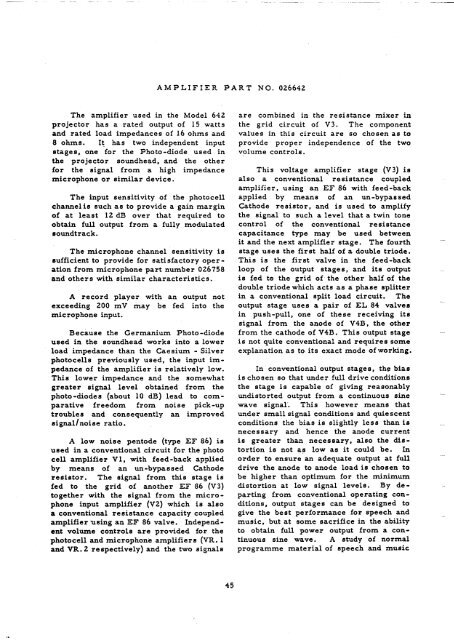Bell & Howell - Projector - Filmosound 641 - 642 ... - Cine Information
Bell & Howell - Projector - Filmosound 641 - 642 ... - Cine Information
Bell & Howell - Projector - Filmosound 641 - 642 ... - Cine Information
You also want an ePaper? Increase the reach of your titles
YUMPU automatically turns print PDFs into web optimized ePapers that Google loves.
The amplifier used in the Model <strong>642</strong><br />
projector has a rated output of 15 watts<br />
and rated load impedances of 16 ohms and<br />
8 ohms. It has two independent input<br />
stages, one for the Photo-diode used in<br />
the projector soundhead, and the other<br />
for the signal from a high impedance<br />
microphone or similar device.<br />
The input sensitivity of the photocell<br />
channel is such as to provide a gain margin<br />
of at least 12 dB over that required to<br />
obtain full output from a fully modulated<br />
soundtrack.<br />
The microphone channel sensitivity is<br />
sufficient to provide for satisfactory operation<br />
from microphone part number 026758<br />
and others with similar characteristics.<br />
A record player with an output not<br />
exceeding 200 mV may be fed into the<br />
microphone input.<br />
Because the Germanium Photo-diode<br />
used in the soundhead works into a lower<br />
load impedance than the Caesium - Silver<br />
photocells previously used, the input impedance<br />
of the amplifier is relatively low.<br />
This lower impedance and the somewhat<br />
greater signal level obtained from the<br />
photo-diode 8 (about 10 dB) lead to comparative<br />
freedom from noise pick-up<br />
troubles and consequently an improved<br />
signal/noise ratio.<br />
A low noise pentode (type EF 86) is<br />
used in a conventional circuit for the photo<br />
cell amplifier VI, with feed-back applied<br />
by means of an un -bypassed Cathode<br />
resistor. The signal from this stage is<br />
fed to the grid of another EF 86 (V3)<br />
together with the signal from the microphone<br />
input amplifier (V2) which is also<br />
a conventional resistance capacity coupled<br />
amplifier rising an EF 86 valve. Independent<br />
volume controls are provided for the<br />
photocell and microphone amplifiers (VR. 1<br />
and VR.2 respectively) and the two signals<br />
AMPLIFIER PART NO. 026<strong>642</strong><br />
45<br />
are combined in the resistance mixer in<br />
the grid circuit of V3. The component<br />
values in this circuit are so chosen as to<br />
provide proper independence of the two<br />
volume controls.<br />
This voltage amplifier stage (V3) is<br />
also a conventional resistance coupled<br />
amplifier, using an EF 86 with feed-back<br />
applied by means of an un-bypassed<br />
Cathode resistor, and is used to amplify<br />
the signal to such a level that a twin tone<br />
control of the conventional resistance<br />
capacitance type may be used between<br />
it and the next amplifier stage. The fourth<br />
stage uses the first half of a double triode.<br />
This is the first valve in the feed-back<br />
loop of the output stages, and its output<br />
is fed to the grid of the other half of the<br />
double triode which acts as a phase splitter<br />
in a conventional split load circuit. The<br />
output stage uses a pair of EL 84 valves<br />
in push-pull, one of these receiving its<br />
signal from the anode of V4B, the other<br />
from the cathode of V4B. This output stage<br />
is not quite conventional and requires some<br />
explanation as to its exact mode of working.<br />
In conventional output stages, the bias<br />
is chosen so that under full drive conditions<br />
the stage is capable of giving reasonably<br />
undistorted output from a continuous sine<br />
wave signal. This however means that<br />
under small signal conditions and quiescent<br />
conditions the bias is slightly less than is<br />
necessary and hence the anode current<br />
is greater than necessary, also the distortion<br />
is not as low as it could be. In<br />
order to ensure an adequate output at full<br />
drive the anode to anode load is chosen to<br />
be higher than optimum for the minimum<br />
distortion at low signal levels. By departing<br />
from conventional operating conditions,<br />
output stages can be designed to<br />
give the best performance for speech and<br />
music, but at some sacrifice in the ability<br />
to obtain full power output from a continuous<br />
sine wave. A study of normal<br />
programme material of speech and music








